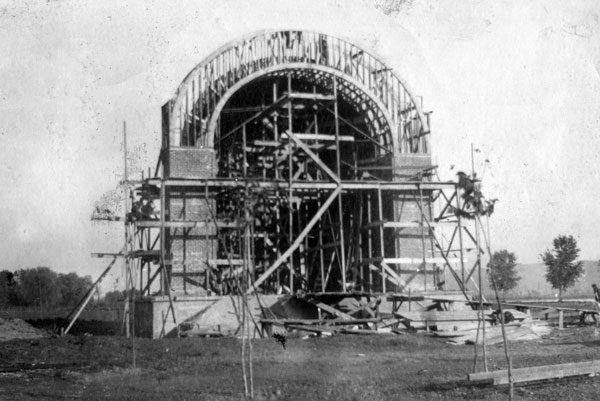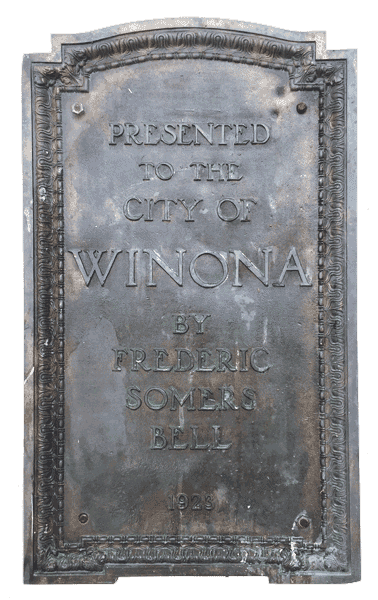The Winona Lake Park Bandshell
Excerpts from the Winona Republican Herald
The New Band Stand and Shelter Pavilion As It Will Appear When Completed at Foot of Main Street
(Winona Republican Herald, June 5, 1915)
Announcement was made in The Republican-Herald a short time ago that the park board had awarded the contract to Seidlitz & Werner to erect a combined band stand and shelter pavilion in the Lake park at the foot of Main Street. Work on this structure is to be pushed to rapid completion, and it will make a distinct addition to Lake park, which, starting with the laying last fall of a brick driveway between Main and Huff streets, and the setting out of trees and shrubs, is now assuming a decidedly parklike appearance.

With the bandstand erected, and concerts provided by Winona’s new Municipal band Lake park will be a most attractive resort at all times during the summer and particularly on park concert evenings. It is expected some time in July to have the bridge completed and driveway across the Huff Street fill finished, this fill being made part of the Lake park scheme. From now on the Lake park can be expected to grow in importance each year. [Editor's note: this project never got off the ground.]
1921: To develop the bandshell site, the Park Board and Fredrick S. Bell concluded that the land needed to be drained by lowering the lake level. City engineer E.E. Chadwick would have to dredge the lake outlet, provide a new channel for Burns Valley Creek, and close the Mankato Ave arch bridge during high water.
1923: Construction of the shell was expected to take 90 days. The band alternated their performance sites hoping that the new bandshell would be done by the end of the summer and become their permanent performance home. In the meantime, concerts were held in Levee Park, East End Baseball Park, and Lake Park at the south end of Main St.
1923: The architectural firm chosen was Clark & Walcott of Chicago. (They were also the architects of the Winona Country Club.) The city engineer established the levels and lines for the location.

1923: Complete description of the bandshell: A stilted half dome, 42 feet wide, set on a platform atop 30-foot piles, made of brick and concrete. The outside width of the platform is 49 feet. The arch is 32 feet high and 28 feet wide, flanked by twin columns and embellished by other architectural features considered dignified and suitable to the place. The shell is 24 feet deep. The spherical roof is made of tin supported by wooden rafters. The lighting consists of ceiling lights inside the shell and trough lights in the cornices about twenty feet from the floor, all throwing their rays upon the inside of the half dome which will reflect and diffuse the light. A flight of easy steps leads from the front of the platform to the ground across the whole front. A large basement, seven feet in the clear, will be used for storage of tools and equipment of the park board’s caretaking crew.[Bandshell under construction. Photo courtesy of the Winona County Historical Society.]
9/1923: Work on the bandshell was rushed to be ready for occupancy when the concert season opened in the spring. “The new stand will be a model of band stand construction and will be one of the most complete and artistic stands in the northwest”, according to the Winona Republican Herald.
5/1924: The Municipal Band played for the Memorial Day service. The service was held in front of the bandshell because the shell wasn’t quite done yet. A temporary platform was set up in front of the permanent seats that had been installed.
6/3/1924: The new bandshell is completed and declared equal to any in the northwest. Its acquisition by the city is to be an occasion of importance.
6/14/1924: Dr. Oswald Leicht, longtime supporter and champion of the Municipal Band, spoke about bandshell donor F.S. Bell: “The gift of the band stand is a fitting climax to Mr. Bell’s many services to the city and his financial support of numerous projects while executive chairman of the Board of Trade, a member of the park board, and the school board and associated with the library board. Every possible thought and effort has been given to make it permanent consistently satisfactory and modern to the last minute.” [Bandshell dedication, June 26, 1924. Photo courtesy of the Winona County Historical Society.]

6/3/1924: The new bandshell is completed and declared equal to any in the northwest. Its acquisition by the city is to be an occasion of importance.
6/14/1924: Dr. Oswald Leicht, longtime supporter and champion of the Municipal Band, spoke about bandshell donor F.S. Bell: “The gift of the band stand is a fitting climax to Mr. Bell’s many services to the city and his financial support of numerous projects while executive chairman of the Board of Trade, a member of the park board, and the school board and associated with the library board. Every possible thought and effort has been given to make it permanent consistently satisfactory and modern to the last minute.” [Bandshell dedication, June 26, 1924. Photo courtesy of the Winona County Historical Society.]
9/10/1935: A contract to paint the bandshell was awarded to a Des Moines Firm, for $147.50. There were 2 other bids.

6/13/1938: The Winona Municipal Band’s opening concert of season was dedicated to the late donor of bandshell, Frederick Somers Bell. “In 1923 came this beautiful gift to the city of Winona from Frederick Somers Bell. Many institutions and individuals have benefited by Mr. Bell’s generousity. Those particularly interested in our band feel that this bandshell is one of his best gifts. It places Winona in the front ranks of cities boasting of first rate bandshell equipment.” We dedicate this program of music to the memory and generosity of Frederick Somers Bell.
The Winona Foundation
William Harris (W.H.) Laird’s daughter, Frances Bradley Laird married Frederic Somers Bell, the donor of our magnificent bandshell. The 2015 Winona Municipal Band Centennial Celebration received a generous donation from the Winona Foundation, a non-profit organization funded and administered by the family and heirs of the Laird Norton Co. which began operations in Winona Minnesota in 1855. The funds they provided are being used to create a documentary about the history of the Winona Municipal Band and our Centennial Celebration. Learn more about the Winona Foundation at winonafoundation.org.
The family created the Winona Foundation in 1982 for the purpose of keeping the family history alive in the minds of new generations and as a way of giving back to the community. We deeply appreciate their support!
